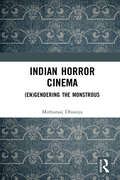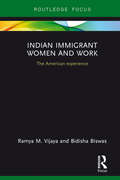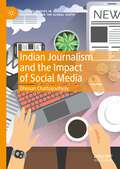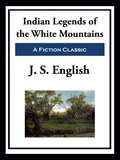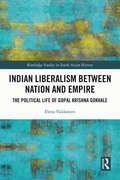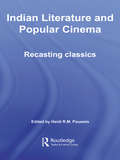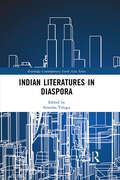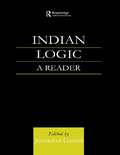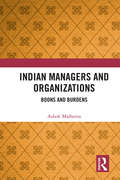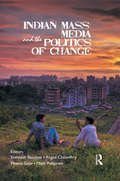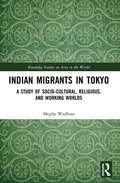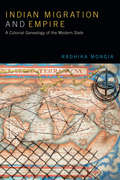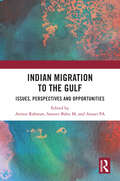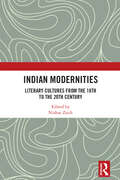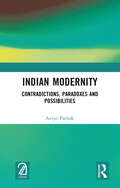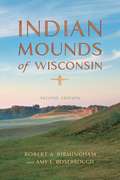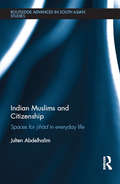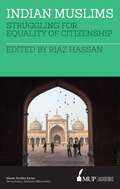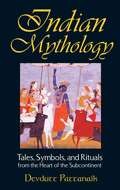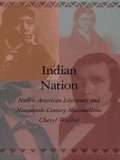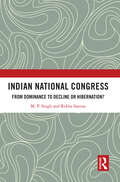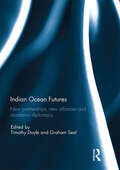- Table View
- List View
Indian Horror Cinema: (En)gendering the Monstrous
by Mithuraaj DhusiyaThis book studies the hitherto overlooked genre of horror cinema in India. It uncovers some unique and diverse themes that these films deal with, including the fear of the unknown, the supernatural, occult practices, communication with spirits of the deceased, ghosts, reincarnation, figures of vampires, zombies, witches and transmutations of human beings into non-human forms such as werewolves. It focusses on the construction of feminine and masculine subjectivities in select horror films across seven major languages – Hindi, Tamil, Telugu, Kannada, Bangla, Marathi and Malayalam. The author shows that the alienation of the body and bodily functions through the medium of the horror film serves to deconstruct stereotypes of caste, class, gender and anthropocentrism. Some riveting insights emerge thus, such as the masculinist undertow of the possession narrative and how complex structures of resistance accompany the anxieties of culture via the dread of laughter. This original account of Indian cinematic history is accessible yet strongly analytical and includes an exhaustive filmography. The book will interest scholars and researchers in film studies, media and cultural studies, art, popular culture and performance, literature, gender, sociology, South Asian studies, practitioners, filmmakers as well as cinephiles.
Indian Immigrant Women and Work: The American experience (Routledge Studies in Asian Diasporas, Migrations and Mobilities #3)
by Ramya M. Vijaya Bidisha BiswasIn recent years, interest in the large group of skilled immigrants coming from India to the United States has soared. However, this immigration is seen as being overwhelmingly male. Female migrants are depicted either as family migrants following in the path chosen by men, or as victims of desperation, forced into the migrant path due to economic exigencies. This book investigates the work trajectories and related assimilation experiences of independent Indian women who have chosen their own migratory pathways in the United States. The links between individual experiences and the macro trends of women, work, immigration and feminism are explored. The authors use historical records, previously unpublished gender disaggregate immigration data, and interviews with Indian women who have migrated to the US in every decade since the 1960s to demonstrate that independent migration among Indian women has a long and substantial history. Their status as skilled independent migrants can represent a relatively privileged and empowered choice. However, their working lives intersect with the gender constraints of labor markets in both India and the US. Vijaya and Biswas argue that their experiences of being relatively empowered, yet pushing against gender constraints in two different environments, can provide a unique perspective to the immigrant assimilation narrative and comparative gender dynamics in the global political economy. Casting light on a hidden, but steady, stream within the large group of skilled immigrants to the United States from India, this book will be of interest to researchers in the fields of political economy, anthropology, and sociology, including migration, race, class, ethnic and gender studies, as well as Asian studies.
Indian Journalism and the Impact of Social Media (Palgrave Studies in Journalism and the Global South)
by Dhiman ChattopadhyayThis book is a pan-India study that examines social media’s impact on Indian journalism, highlights emerging challenges, and discusses the way forward for India’s newsrooms. A result of three years of field work, the project uses mixed-methods research – a survey of nearly 300 journalists from 15 Indian cities, followed by in-depth interviews with 25 senior editors – to analyze and explain journalists’ perceptions about social media’s usefulness and credibility, factors that influence their online news sourcing and sharing decisions, resultant challenges for newsrooms, and ways to address those challenges. The findings offer unique insights into how newer forces are influencing journalistic practices in an online-first era. Key differences emerge in perceptions between Indian journalists and their Western compatriots about who or what influence their actions. The findings also raise questions about Gatekeeping as a term to describe journalistic work in 21st Century India's newsrooms. The findings and the conclusions will hopefully help journalists, educators, and anyone interested in Indian journalism gain a deeper, more meaningful understanding about social media’s impact on Indian journalism, and the way ahead for India’s newsrooms.
Indian Legends of the White Mountains
by J. S. EnglishIndian Legends of the White Mountains is a collection of Folklore from in and around the &“Crystal Hills&” of New Hampshire gathered from tales of old settlers and records in historical societies and town libraries. Included are: Chocorua Mount Washington The Giant&’s Grave Nancy&’s Brook The Red Carbuncle Ellis River Ellis River and Jackson, N. H. Moosilauke and the Pemigewassets Cold Streams Rogers&’ Rangers and the Sack of St. Francis Legend of Eagle Mountain Captain Lovewell&’s Fight with Paugus
Indian Liberalism between Nation and Empire: The Political Life of Gopal Krishna Gokhale (Routledge Studies in South Asian History)
by Elena ValdameriThis book analyses the political thought and practice of Gopal Krishna Gokhale (1866–1915), preeminent liberal leader of the Indian National Congress who was able to give a ‘global voice’ to the Indian cause. Using liberalism, nationalism, cosmopolitanism and citizenship as the four main thematic foci, the book illuminates the entanglement of Gopal Krishna Gokhale’s political ideas and action with broader social, political and cultural developments within and beyond the Indian national frame. The author analyses Gokhale’s thinking on a range of issues such as nationhood, education, citizenship, modernity, caste, social service, cosmopolitanism and the ‘women’s question,’ which historians have either overlooked or inserted in a rigid nation-bounded historical narrative. The book provides new enriching dimensions to the understanding of Gokhale, whose ideas remain relevant in contemporary India. A new biography of Gokhale that brings into consideration current questions within historiographical debates, this book is a timely and welcome addition to the fields of intellectual history, the history of political thought, Colonial history and Indian and South Asian history.
Indian Literature and Popular Cinema: Recasting Classics (Routledge Contemporary South Asia Series)
by Heidi R.M.PauwelsThis book is about the popular cinema of North India ("Bollywood") and how it recasts literary classics. It addresses questions about the interface of film and literature, such as how Bollywood movies rework literary themes, offer different (broader or narrower) interpretations, shift plots, stories, and characters to accommodate the medium and the economics of the genre, sometimes even changing the way literature is read. This book addresses the socio-political implications of popular reinterpretations of "elite culture", exploring gender issues and the perceived "sexism" of the North Indian popular film and how that plays out when literature is reworked into film. Written by an international group of experts on Indian literature and film, the chapters in this book focus on these central questions, but also cover a wide range of literary works that have been adapted in film. Each part of the book discusses how a particular genre of literature has been "recast" into film. The individual chapters focus on comparisons and close studies of individual films or film songs inspired by "classics" of literature. The book will be of interest to those studying Indian film and literature and South Asian popular culture more generally.
Indian Literatures in Diaspora (Routledge Contemporary South Asia Series)
by Sireesha TeluguThis book analyses diasporic literatures written in Indian languages written by authors living outside their homeland and contextualize the understanding of migration and migrant identities. Examining diasporic literature produced in Bengali, Hindi, Malayalam, Indian Nepali, Odia, Punjabi, Marathi, and Tamil, the book argues that writers in the diaspora who choose to write in their vernacular languages attempt to retain their native language, for they believe that the loss of the language would lead to the loss of their culture. The author answers seminal questions including: How are these writers different from mainstream Indian writers who write in English? Themes and issues that could be compared to or contrasted with the diasporic literatures written in English are also explored. The book offers a significant examination of the nature and dynamics of the multilingual Indian society and culture, and its global readership. It is the first book on Indian diasporic literature in Indian and transnational languages, and a pioneering contribution to the field. The book will be of interest to academics in the field of South Asian Studies, South Asian literature, Asian literature, diaspora and literary studies.
Indian Logic: A Reader (Suny Series In Indian Thought: Texts And Studies)
by Dr Jonardon GaneriThe articles in this volume are all landmarks in the evolution of modern studies in Indian logic. The book traces the development of modern studies in Indian logic from their beginnings right up to the latest work.
Indian Managers and Organizations: Boons and Burdens
by Ashok MalhotraCulture is critical to individuals and organizations. This book takes a close look into the way Indian managers work, their inner struggles, and forces that shape their behaviour. It presents an original framework developed by the author — the Existential Universe Mapper (EUM), a pluralistic and non-reductionist model of management that uses a new psychometric instrument to map individual and organization identity. The model restrains from placing any phenomenon into frozen categories and enables an understanding of their interplay. The volume points to India’s ambivalent relationship with modernity, and the consequent difficulty of Indian managers in embracing the imperatives of the corporate world that are largely based on Anglo-Saxon frames. This book will be of interest to those in business management, human resource management, leadership studies, corporate governance, industries, education, social sector, governance, psychology, and sociology. It will be particularly relevant for scholars, educators, consultants, practitioners of management and corporate leaders.
Indian Mass Media and the Politics of Change
by Somnath Batabyal Angad Chowdhry Meenu Gaur Matti PohjonenIndia has been the focus of international attention in the past few years. Rhetoric concerning its rapid economic growth and the burgeoning middle classes suggests that something new and significant is taking place. Something has changed, we are told: India is shining, the elephant is rising, and the 21st century will be Indian. What unites these powerful re-imaginings of the Indian nation is the notion of change and its many ramifications. Election campaigns, media commentators, scholars, activists and drawing room debates all cut their teeth around this complex notion. Who is it that benefits from this change? Do such re-imaginings of nationhood really reflect the complex social reality of large parts of the Indian population? The book starts with the premise that it is within the mass media where we can best understand how this change is imagined. From a kaleidoscope of perspectives the book interrogates this articulation and the myriad forms it takes – across India's newsrooms, television sets, cinema halls, mobile phones and computer screens.
Indian Migrants in Tokyo: A Study of Socio-Cultural, Religious, and Working Worlds (Routledge Studies on Asia in the World)
by Megha WadhwaHow does an extended stay in Japan influence Indian migrants’ sense of their identity as they adapt to a country very different from their own? The number of Indians in Japan is increasing. The links between Japan and India go back a long way in history, and the intricacy of their cultures is one of the many factors they have in common. Japanese culture and customs are among the most distinctive and complex in the world, and it is often difficult for foreigners to get used to them. Wadhwa focuses on the Indian Diaspora in Tokyo, analysing their lives there by drawing on a wealth of interviews and extensive participant observation. She examines their lifestyles, fears, problems, relations and expectations as foreigners in Tokyo and their efforts to create a 'home away from home' in Japan. This book will be of great interest to anthropologists and sociologists concerned with the impact of migration on diaspora communities, especially those focused on Japan, India or both.
Indian Migration and Empire: A Colonial Genealogy of the Modern State
by Radhika MongiaHow did states come to monopolize control over migration? What do the processes that produced this monopoly tell us about the modern state? In Indian Migration and Empire Radhika Mongia provocatively argues that the formation of colonial migration regulations was dependent upon, accompanied by, and generative of profound changes in normative conceptions of the modern state. Focused on state regulation of colonial Indian migration between 1834 and 1917, Mongia illuminates the genesis of central techniques of migration control. She shows how important elements of current migration regimes, including the notion of state sovereignty as embodying the authority to control migration, the distinction between free and forced migration, the emergence of passports, the formation of migration bureaucracies, and the incorporation of kinship relations into migration logics, are the product of complex debates that attended colonial migrations. By charting how state control of migration was critical to the transformation of a world dominated by empire-states into a world dominated by nation-states, Mongia challenges positions that posit a stark distinction between the colonial state and the modern state to trace aspects of their entanglements.
Indian Migration to the Gulf: Issues, Perspectives and Opportunities
by Anisur Rahman, Sameer Babu M, and Ansari P AThis book explores issues of rights, issues, and challenges faced by Indian migrant workers in the GCC countries. It focuses on the struggle of migrants in the state of origin and destination states and how the process of migration shapes the identity and existence of migrant workers. The essays in the volume focus on policy, rights, issues, and challenges faced by migrants as well as the long-term challenges posed by the COVID-19 pandemic. With contributions from academics and policymakers, this book will be of interest to scholars and researchers of migration and diaspora studies, public policy, and South Asian Studies.
Indian Modernities: Literary Cultures from the 18th to the 20th Century
by Nishat ZaidiThis volume studies the ways in which modernity has been conceived, practiced, and performed in Indian literatures from the 18th to 20th century. It brings together essays on writings in Hindi, Urdu, Punjabi, Bengali, Odia, Gujarati, Marathi, Tamil, Telugu, Kannada, Malayalam, and languages from Northeast India, which form a dialogical relationship with each other in this volume. The concurrence and contradictions emerging through these studies problematize the idea of modernity afresh. The book challenges the dominance of colonial modernity through socio-historical and cultural analysis of how modernity surfaces as a multifaceted phenomenon when contextualized in the multilingual ethos of India. It further tracks the complex ways in which modernism in India is tied to the harvests of modernity. It argues for the need to shift focus on the specific conditions that gave shape to multiple modernities within literatures produced from India. A versatile collection, the book incorporates engagements with not just long prose fiction but also lesser-known essays, research works, and short stories published in popular magazines. This unique work will be of interest to students and teachers of Indian writing in English, Indian literatures, and comparative literatures. It will be indispensable to scholars of South Asian studies, literary historians, linguists, and scholars of cultural studies across the globe.
Indian Modernity: Contradictions, Paradoxes and Possibilities
by Avijit PathakIndian Modernity (first published in 1998) acquires a new meaning today. While it critiques a techno-militaristic model of modernization, it visualizes alternative possibilities to give a distinctively new definition to our modernity. It engages the reader in dreaming of a new path to modernity beyond its present contradictions and paradoxes with its lyrical style, philosophic insights, sensitivity to deep religiosity, life-affirming femininity and, most of all, sociological imagination. This book continues to hold relevance for social science students and researchers, teachers, and visionaries, despite the passage of time. This title is co-published with Aakar Books. Print editions not for sale in South Asia (India, Sri Lanka, Nepal, Bangladesh, Pakistan and Bhutan)
Indian Mounds of Wisconsin
by Robert A. Birmingham Amy L. RosebroughMore mounds were built by ancient Native Americans in Wisconsin than in any other region of North America—between 15,000 and 20,000, at least 4,000 of which remain today. Most impressive are the effigy mounds, huge earthworks sculpted in the shapes of thunderbirds, water panthers, and other forms, not found anywhere else in the world in such concentrations. This second edition is updated throughout, incorporating exciting new research and satellite imagery. Written for general readers, it offers a comprehensive overview of these intriguing earthworks. Citing evidence from past excavations, ethnography, the traditions of present-day Native Americans in the Midwest, ground-penetrating radar and LIDAR imaging, and recent findings of other archaeologists, Robert A. Birmingham and Amy L. Rosebrough argue that effigy mound groups are cosmological maps that model belief systems and relations with the spirit world. The authors advocate for their preservation and emphasize that Native peoples consider the mounds sacred places. This edition also includes an expanded list of public parks and preserves where mounds can be respectfully viewed, such as the Kingsley Bend mounds near Wisconsin Dells, an outstanding effigy group maintained by the Ho-Chunk Nation, and the Man Mound Park near Baraboo, the only extant human-shaped effigy mound in the world.
Indian Muslims and Citizenship: Spaces for Jihād in Everyday Life (Routledge Advances in South Asian Studies)
by Julten AbdelhalimThrough the creation of post-colonial citizenship, India adopted a hybridisation of specific secular and western conception of citizenship. In this democratic framework, Indian Muslims are observed on how they make use of the spaces and channels to accommodate their Islamic identity within a secular one. This book analyses how the socio-political context shapes citizens’ perceptions of multiple variables, such as their sense of political efficacy, agency, conception of citizenship rights and belief in democracy. Based on extensive surveys and interviews and through presenting and investigating the various meanings of jihād, the author explores the usage of non-Eurocentric conceptual approaches to the study of postcolonial and Muslim societies, in particular the meaning it carries in the psyche of the Muslim community. She argues that through means of argumentative and spiritual jihād, Indian Muslims fight their battle towards a realisation of citizenship ideals despite the unfavourable conditions of intra and inter community conflicts. Presenting new examinations of Islamic identity and citizenship in contemporary India, this book will be a useful contribution to the study of South Asian Studies, Religion, Islam, and Race and Ethnicity.
Indian Muslims: Struggling for Equality of Citizenship (Islamic Studies Series)
by Riaz HassanResearch shows that Indian Muslims experience higher levels of development and equity deficits. Indian Muslims are also predicted to become the largest Muslim population in the world by 2050. This increase in numbers might exacerbate their relative deprivation, creating a disjunction between India's constitutional promises of 'equality of opportunity' for citizens of a secular democracy—including for minorities—and the existential reality. This will create social and political conditions that could undermine the stability of the country's democracy and make Indian Muslims a security threat, which would have not only national but also global ramifications. This book examines the struggle for equality of citizenship of Indian Muslims in light of the release of the Sachar Committee report of 2006, which sparked widespread awareness of socioeconomic disparity and exclusion of religious minorities in India, especially Muslims. The contributors are some of the most eminent social scientists in the fields of applied economics, politics, sociology and demography who work on Indian issues. The Indian state and its political infrastructure have been relatively successful thus far in countering the challenges presented by the diversity of its population. India therefore has the capacity and the ability to deal with these new challenges, given the political and collective will. Islamic Studies Series - Volume 22
Indian Mythology: Tales, Symbols, and Rituals from the Heart of the Subcontinent
by Devdutt PattanaikAn exploration of 99 classic myths of India from an entirely non-Western paradigm that provides a fresh understanding of the Hindu spiritual landscape• Compares and contrasts Indian mythology with the stories of the Bible, ancient Egypt, Greece, Scandinavia, and Mesopotamia• Looks at the evolution of Indian narratives and their interpretations over the millennia• Demonstrates how the mythology, rituals, and art of ancient India are still vibrant today and inform the contemporary generationFrom the blood-letting Kali to the mysterious Ganesha, the Hindu spiritual landscape is populated by characters that find no parallel in the Western spiritual world. Indian Mythology explores the rich tapestry of these characters within 99 classic myths, showing that the mythological world of India can be best understood when we move away from a Western, monotheistic mindset and into the polytheistic world of Hindu traditions.Featuring 48 artistic renderings of important mythological figures from across India, the author unlocks the mysteries of the narratives, rituals, and artwork of ancient India to reveal the tension between world-affirming and world-rejecting ideas, between conformism and contradiction, between Shiva and Vishnu, Krishna and Rama, Gauri and Kali. This groundbreaking book opens the door to the unknown and exotic, providing a glimpse into the rich mythic tradition that has empowered millions of human beings for centuries.
Indian Nation: Native American Literature and Nineteenth-Century Nationalisms
by Cheryl WalkerIndian Nation documents the contributions of Native Americans to the notion of American nationhood and to concepts of American identity at a crucial, defining time in U.S. history. Departing from previous scholarship, Cheryl Walker turns the "usual" questions on their heads, asking not how whites experienced indigenous peoples, but how Native Americans envisioned the United States as a nation. This project unfolds a narrative of participatory resistance in which Indians themselves sought to transform the discourse of nationhood.Walker examines the rhetoric and writings of nineteenth-century Native Americans, including William Apess, Black Hawk, George Copway, John Rollin Ridge, and Sarah Winnemucca. Demonstrating with unique detail how these authors worked to transform venerable myths and icons of American identity, Indian Nation chronicles Native American participation in the forming of an American nationalism in both published texts and speeches that were delivered throughout the United States. Pottawattomie Chief Simon Pokagon's "The Red Man's Rebuke," an important document of Indian oratory, is published here in its entirety for the first time since 1893. By looking at this writing through the lens of the best theoretical work on nationality, postcoloniality, and the subaltern, Walker creates a new and encompassing picture of the relationship between Native Americans and whites. She shows that, contrary to previous studies, America in the nineteenth century was intercultural in significant ways.
Indian National Congress: From Dominance to Decline or Hibernation?
by Rekha Saxena M. P. SinghThis book presents a systematic analysis of the rise and decline of the Indian National Congress since 1980s, using the frame dominance to hibernation. The Indian National Congress (INC or Congress Party) originated in the national movement for India`s freedom and has since been the centerpiece of post-Independence multiparty system for nearly four decades. However, the Congress has been experiencing a phase of serious decline since the 2014 and 2019 General Elections. Analyzing years of political history and contemporary developments, this volume brings to the fore important issues and key themes such as, • Evolution of party system in India, the contemporary dynamics and movements; • Indian National Congress under Indira Gandhi and Rajiv Gandhi; • Ideological and policy reorientation of the party in 1990s under P. V. Narsimha Rao; • Revival of mass membership and organizational elections in the party; • Indian National Congress in the 2000s, under the leadership of Sonia Gandhi and Rahul Gandhi; • The 2019 debacle and change in the leadership. A comprehensive work on the history of the Congress Party in India, this volume will be an essential read for scholars and researchers of political science, party politics, Indian politics, sociology, modern Indian history, political sociology, public administration, public policy, South Asian studies, and governance studies.
Indian Ocean Futures: New Partnerships, New Alliances, and Academic Diplomacy
by Graham Seal Timothy DoyleIndian Ocean studies, which once lagged behind studies of the Atlantic and the Pacific, is an important emerging academic field which has come into its own. In the next fifty years, the Indian Ocean Region will become very significant as a result of enormous demographic changes. What was the Ocean of the South is rapidly becoming the Ocean of the Centre, the Ocean of the Future. Curtin University, Western Australia, has a long and distinguished history of engagement with the Indian Ocean region and with Indian Ocean Studies, and its Australia-Asia-Pacific Institute of Curtin University continues to maintain a focus on the Indian Ocean -past, present and future. This book examines a number of themes emerging from its 2014 Conference entitled "Indian Ocean Futures", which attracted some of the best Indian Ocean region scholars. The conference connected humanities, social sciences and scientific disciplines; this book collects some of the preeminent works focused on geo-strategic, cultural, environmental security and human security themes. The book is also an important contribution to the building of academic diplomacy in the region – that is to say, it contributes to region-building by creating epistemic communities and networks between government, the private sector, and academia throughout the region. Through the pursuit of academic diplomacy, academics are capable of pursuing research goals which enhance governmental, business, and civil society objectives of the day. This book was previously published as a special issue of the Journal of the Indian Ocean Region.
